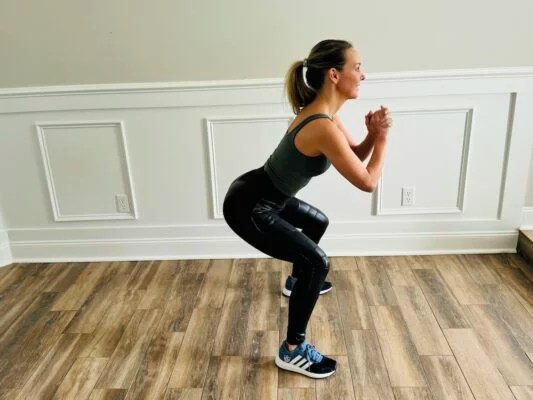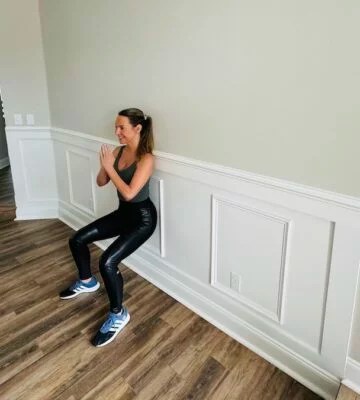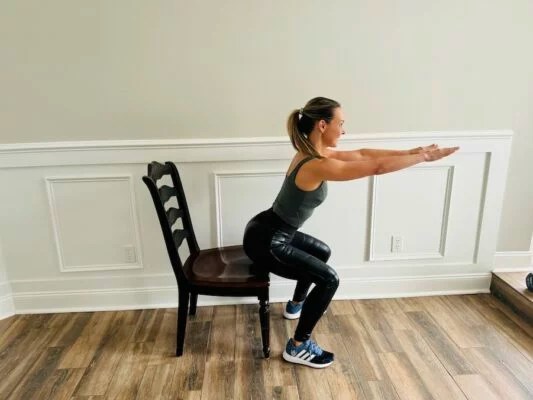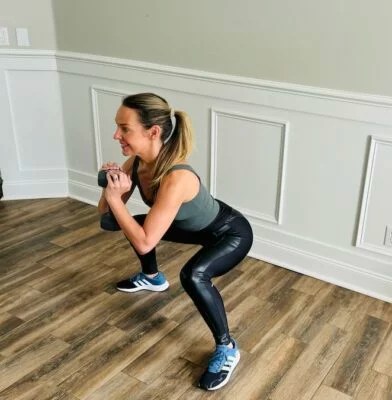It is easy to wax poetic about the benefits of the squat. In fact, if you ask most fitness professionals about their favorite exercises, most will have the squat at the top of their list.
The basic squat is impressive on its own, but the fact you can make it easier, harder, or even to work your muscles differently makes it an exercise that almost everyone can (and should!) do.
“Squats are one of the best compound movements for overall fitness development,” says Andrew Peak, CPT, corrective exercise specialist and founder of Garage Gym Greatness.
Which muscles do squats work?
- Primary muscles: The primary muscle groups that squats work are the glutes (gluteus maximus, minimus, and medius), the quadriceps, the hamstrings, and the adductor (groin) muscle.
- Secondary muscles: “We often think about the large muscle groups when performing a squat (quadriceps, glutes, and hamstrings), but we also activate small supporting muscle groups—like deep core stabilizers [rectus abdominus, transverse abdominis, erector spinae], obliques, hip flexors, foot, and calf muscles,” says Ash Wilking, CPT, certified personal trainer and Tonal strength coach.
“It’s safe to say that squats provide an almost total-body workout,” Peak says. This includes not only your legs, but also your core. Although traditional squats don’t work your upper body, there are plenty of squat variations that focus on specific muscles, like your glutes.
How to do a basic squat with perfect form
It is important you have proper form while doing the basic squat to get the maximum benefit and to prevent injuries.
“You should also use a mirror or have someone watch your squat form to be sure you are aligned nicely,” Peak says.

- Stand with your feet shoulder-width apart, shoulders back, your toes slightly turned out, and your arms at your side.
- Bend your knees as you push your hips back and shift your weight onto your heels as you squat down.
- Keep your chest up and your core tight. Your arms can come up in front as you squat down.
- Squat down until your knees are parallel to the ground—or stop before that if you have pain or can’t maintain proper form.
- Squeeze your glutes and push through your heels to straighten your legs and return to a standing position.
- Repeat for 2 to 3 sets of 1 to 15 reps.
8 benefits of squats that’ll convince you to get low
Now that you know how to do a basic squat, you need to know why you should do them. Here are eight reasons the squat deserves a spot in your exercise routine.
1. They work several large muscle groups
“The squat is a fantastic compound movement that not only builds lower body strength and power, but also works trunk or core strength and stability,” Wilking says.
Peak agrees.
“While the primary focus of the lift is on the legs, you must actively engage your core and back muscles to maintain proper form,” he says.
2. They strengthen your core better than planks
Not a fan of the plank? As it turns out, squats strengthen your core better than planking.
A small June 2018 study in the Journal of Human Kinetics compared planking with back squats, which is a squat variation in which you hold a weighted barbell while squatting. Researchers found there was greater core activation, specifically in the erector spinae muscles (deep back muscles), with squatting versus planking.
3. They’re a functional exercise
“Squats boost functional mobility and help with everyday activities,” Peak says.
These involve activities like standing up from sitting in a chair, getting up from the toilet, and getting in and out of your car.
In fact, the squat is the top exercise you should do as you get older to not only maintain mobility but also to protect your knee and hip joints and maintain your balance, according to AARP.
4. They prevent falls
An August 2018 study in Chiropractic & Manual Therapies found that older people who had stronger quadriceps muscles were significantly less likely to fall versus those who had weakness in this muscle.
Squats are a fabulous exercise to keep your quads strong to help improve balance and mobility as you age.
5. They boost athletic ability
Looking for a way to increase your speed and explosive strength? It’s time to add jump squats to your training routine.
A small September 2016 study in Sports Science & Medicine found that those who did jump squats three times a week for eight weeks boosted their athletic performance in these areas.
6. They improve bone density
Resistance training is one of the best things you can do to improve your bone density and prevent conditions like osteoporosis.
A December 2020 study in Osteoporosis and Sarcopenia found doing compound resistance exercises, like squats, helps to improve both bone density and muscle mass.
7. They improve flexibility
“Squatting can also help to improve flexibility,” Wilking says.
As you perform the squat, you are improving range of motion in your hips, knees, and ankles.
8. They’re an accessible exercise
Even though you can do squats with equipment or on a machine at the gym, the basic squat can be done using only your body weight. It doesn’t require much room or fancy equipment—just your muscle!
“Squats are one of the best compound movements for overall fitness development.” —Andrew Peak, CPT
6 squat variations to make the move easier or harder
The basic squat is great all on its own, but there are several variations for both beginners and those who are looking for a challenge. Try out these six variations, starting with beginner modifications and progressing to weighted and plyometric squat options.
1. Wall squat
For those who don’t quite have the leg strength to perform a squat with good form, doing a wall squat can help give you added support.
“You can also reduce the resistance by holding onto something like a chair or gym rack. Doing this will use your upper body to take some of the weight and make the squats easier,” Peak says.

- Stand with your back against the wall.
- Your feet should be about 12 to 15 inches from the wall, placed shoulder-width apart, with toes slightly turned out.
- Bend your knees as you slowly slide down the wall, stopping when your thighs are parallel to the ground—or wherever is most comfortable.
- Push through your heels back to standing.
- Repeat 2 to 3 sets of 10 to 12 reps.
2. Box squat
The box squat is another good beginner squat move for those who need to build up leg strength for the basic squat—or those who have knee or hip issues. It’s also a great way to work on your squat form.

- Stand a few inches away from a chair, bench, or box, with your back facing away.
- Stand in the squat position, with your feet shoulder-width apart and your toes slightly turned out.
- Bend your knees as you push your hips back into a squatting position.
- Continue lowering down until your butt touches the box (but don’t sit all the way down).
- As soon as your butt taps the box, push through your heels to return to a standing position.
- Repeat 2 to 3 sets of 10 to 12 reps.
3. Goblet squat
The goblet squat requires you to hold a kettlebell or dumbbell, which means it works your arms and the muscles in your legs more than a traditional squat. Holding the weight in front also means it kicks your core muscles into overdrive to keep you upright.

- Hold a dumbbell, kettlebell, or weighted plate with both hands at chest height.
- Stand in the squat position, with your feet shoulder-width apart and your toes slightly turned out.
- Bend your knees as you push your hips back into a squat position.
- Keep the weight in front and your trunk upright throughout the motion.
- Squat down until your hips are below your knees. (If you can’t squat this low, go as far down as you comfortably can.)
- At the end of the motion, keep your elbows inside of your knees.
- Push through your heels to stand up and return to starting position.
- Repeat 1 to 2 sets of 10 to 12 reps.
4. Back squat
A back squat requires you to hold a barbell on your shoulders for added weight.

- Place a barbell (weighted or just the bar) behind your neck resting on your shoulders. Hold the barbell at either end with your palms facing away from your body.
- Stand with your feet shoulder-width apart, shoulders back, your toes slightly turned out, and your arms at your side.
- Bend your knees as you push your hips back and shift your weight onto your heels as you squat down.
- Keep your chest up and your core tight.
- Squat down until your knees are parallel to the ground —or stop before that if you have pain or can’t maintain proper form.
- Squeeze your glutes and push through your heels to straighten your legs and return to a standing position.
- Repeat 2 to 3 sets of 1 to 15 reps.
5. Overhead squat
The overhead squat works your arms, including your deltoids and triceps, as well as your core to help balance you. It also improves your flexibility in your arms and thoracic spine.

- Stand in the squat position, with your feet shoulder-width apart and your toes pointed slightly out.
- Hold a barbell or ball over your head. (If holding a barbell, grasp it at either end with your palms facing away from your body.)
- Bend your knees as you push your hips back and shift your weight onto your heels as you squat down.
- Squat down until your knees are parallel to the ground—or stop before that if you have pain or can’t maintain proper form.
- Squeeze your glutes and push through your heels to straighten your legs and return to a standing position.
- Repeat 2 to 3 sets of 1 to 15 reps.
6. Jump squat
A jump squat is the plyometric exercise that helps improve speed and explosive strength.

- Stand with your feet shoulder-width apart, shoulders back, your toes slightly turned out and your arms held up in front.
- Bend your knees as you push your hips back and shift your weight onto your heels as you squat down.
- Keep your chest up and your core tight.
- Squat down until your knees are parallel to the ground—or stop before that if you have pain or can’t maintain proper form.
- As you reach the bottom of the squat position, push through your toes to explode up to jump in the air. Both your feet should come off the ground.
- Land softly down, letting your knees bend slightly.
- Repeat 2 to 3 sets of 10 reps.
Common form mistakes and safety tips
If you have had any recent hip or knee injuries, talk to your doctor before starting a new exercise routine. Stop any exercise that gives you pain and consider squat alternatives to strengthen your legs instead. Ensure you’re using the proper squat form, and make sure you aren’t doing any of these common squat form mistakes.
1. Watch your knees
Your knees shouldn’t cave in while performing a squat.
“Ensure your knees are aligned with your toes for the whole movement,” Peak says. “I often tell clients to imagine they are pushing their knees out to the side while squatting. This mental cue will help maintain form.”
2. Keep your chest up
Don’t let your chest fall forward while squatting. As you push your hip back for the squat, your trunk will bend forward—but keep your shoulders back and your chest up.
3. Watch your toes
Your toes should either be pointed forward or just slightly turned out during a squat. Listen to your body and place your toes in the spot that feels like the best alignment for you.
Pointing your toes further out can be done with deep squats to gain more range, however, pay close attention to your knees as this position does put extra stress on your joints. You should also make sure you are wearing the right shoes for deep squats.
4. Gradually increase the weight
When doing weighted squats, Wilking says not to start with too much weight.
“Many times we can feel discomfort because our bodies need to build a tolerance to the movement and the additional load,” she says. “This is where progressive overload is key. Slow and steady increase in weight will always win the race.”
5. Warm up properly
Before doing resistance training like squats, Peak says to do a 10- to 15-minute warm-up.
“Ensure you’ve done some basic cardio to get the blood flowing and body temperature up,” he says. “Next, you need to do some dynamic stretches to warm up the muscles and joints.”
FAQ
1. How much rest time should you have between squat sets?
Peak says it depends on your goals. “Reducing the recovery time between sets means you’re body will have less energy to perform the next set.”
Typically a rest of between two and five minutes is used for strength training for heavy loads, he says. For building muscle mass or hypertrophy, he says to rest between 30 and 90 seconds.
2. How many squats should you do?
“My recommendation is to perform squats no more than three times a week and to allow at least one day’s recovery between squat sessions,” Peak says.
As far as how many to do, it depends on your goal, he says.
“As a general rule, if you’re looking to develop your squats in a safe, methodical, and balanced way, you need to cycle your training,” he says.
Peak gives this example of a squat training routine:
- Cycle 1 – endurance training: 6 to 8 weeks of moderate to high reps and sets, 4 to 5 sets of 15 to 20
- reps per session.
- Cycle 2 – hypertrophy training to build muscle mass: 6 to 8 weeks of moderate reps, 3 to 4 sets of 6 to 12 reps per
- session.
- Cycle 3 – strength training: 6 to 8 weeks of low reps, 5 sets of 5 reps per session.
3. Is it okay if my heels come up during squats?
If your heels come up during squats, it probably means a lack of flexibility at your ankles. You should do calf stretches to improve flexibility.
Also, modify your squats so you can maintain proper form.
“A common modification when squatting is to elevate the heels slightly,” Willking says.
To do this, place a weight plate under your heels.
Well+Good articles reference scientific, reliable, recent, robust studies to back up the information we share. You can trust us along your wellness journey.
- van den Tillaar R, Saeterbakken AH. Comparison of Core Muscle Activation between a Prone Bridge and 6-RM Back Squats. J Hum Kinet. 2018 Jun 13;62:43-53. doi: 10.1515/hukin-2017-0176. PMID: 29922376; PMCID: PMC6006542.
- Ahmadiahangar A, Javadian Y, Babaei M, Heidari B, Hosseini S, Aminzadeh M. The role of quadriceps muscle strength in the development of falls in the elderly people, a cross-sectional study. Chiropr Man Therap. 2018 Aug 6;26:31. doi: 10.1186/s12998-018-0195-x. PMID: 30128111; PMCID: PMC6091154.
- Marián V, Katarína L, Dávid O, Matúš K, Simon W. Improved Maximum Strength, Vertical Jump and Sprint Performance after 8 Weeks of Jump Squat Training with Individualized Loads. J Sports Sci Med. 2016 Aug 5;15(3):492-500. PMID: 27803628; PMCID: PMC4974862.
- Nguyen HG, Pham MT, Ho-Pham LT, Nguyen TV. Lean mass and peak bone mineral density. Osteoporos Sarcopenia. 2020 Dec;6(4):212-216. doi: 10.1016/j.afos.2020.10.001. Epub 2020 Nov 6. PMID: 33426311; PMCID: PMC7783218.
